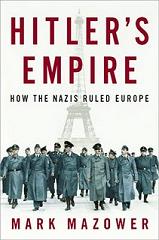
Mediterranean Front, A Year of Battle, The End in Africa
Alan Moorehead
642 pages including index
published in 1941, 1943,1943, compilation 1945
If journalism is history as first draft, then these three books, Mediterranean Front, A Year of Battle, The End in Africa; published in one volume as African Trilogy are history as second draft. Written while the Second World War was still ongoing, each of these books tell the story of one year of war in the desert, as seen by one of the preeminent war correspondents of the era. Written largely without the benefit of hindsight, from the notes that Moorehead took at the time, these three books together not only provide an interesting look at an important period in World War II, which England largely had to fight on its own, but also at how people at the time thought about the war, when the outcome was by no means certain yet.
If you’ve heard of Alan Moorehead, it’s probably for his post-war books on the exploration of the Nile, The White Nile (1960) and The Blue Nile (1962). During the Second World War he was a correspondent for the Daily Express, following the war in North Africa, the invasion of Sicily and the war in Italy. As becomes clear from reading these three volumes, Moorehead wasn’t one of those journalists content to stay at headquarters, but went chasing down the front whenever he could. Some of the incidents here certainly read like Boy’s Own Adventures stuff, several times barely escaping running into the enemy at several moments. Moorehead is a born raconteur, aimable, slightly understated, though with some of the attitudes and language use of the time that might seem strange to modern readers.
Mediterranean Front is the story of the first year of war in the desert, from 1940 to 1941, at time when the UK stood alone against Germany, and in the Middle East, Italy. Italy had only declared war on England in June of 1940, had overwhelming numerical superiority over the British and Commonwealth forces and was poised to overrun not just Egypt from Libya, but also much of the British Empire in East Africa from Italian Somalia and Ethiopia. For obvious reasons, there wasn’t much chance of reinforcement from home, nor was the equipment available first rate. Despite this, never in Moorehead’s account do you get a feeling of despair or that the troops were particularly worried. Concerned yes and the commanders certainly were aware of their limitations, but they come over as determined to overcome these without being reckless.
In that first year of battle the see-saw nature of war in the Western Desert already is clear. The Italians are the first to go on the offensive, get into Egypt but can’t go further, a smart counteroffensive by Wavell manages not only to get them out of Egypt, but overruns most of Italian Libya, but in turn can’t quite get to Tripoli. This gave the Germans the chance to come to the aid of their allies and in turn they drove back the British and Commenwealth forces. This pattern would last throughout the war in the desert, up until the Allied landings in French North Africa broke the deadlock.
In that first year of battle the British had more to deal with than just the Western Desert. There’s the struggle in East Africa, the British occupation of French ruled Syria that concludes the first volume, a pro-Axis coup in Iraq and most importantly, the British expedition to support Greece in its defence against the Italians, which goes disastrously wrong. Moorehead is there for most of these secondary campaigns, following them for longer or shorter times, making an effort to show how they influenced the main effort in Libya and Egypt.
But he always returns to the Western Desert, as in the second volume, a Year of Battle, which starts with the joint British-Russian takeover of Persia/Iran, which Moorehead witnesses from nearby. The struggle in the second year of desert warfare is simpler, as with the British failure in Greece and success in East Africa, Syria and Persia only the Western Desert remains as an active theatre. This time it’s the British who have the succesful offensive only to run out of steam and the Africa Korps who manages to successfully counter and overrun almost all British defences, including Tobruk. Again, despite the seriousness of the situation Moorehead shows no despair on the side of the British, though there is panic as the Germans seem poised to take Alexandria and Cairo. Since this book too was published during the war, you do wonder briefly how much here has been (self) censored, but Moorehead seems remarkably honest about the mistakes and faults of the British and their commanders.
Moorehead is no longer in the desert at the start of the third book, having left the Middle East behind for some assignments in America, missing the start of the invasion but making use of this to sail to Africa with an escort to a convoy. Once in Africa, he has to split his time between the First Army moving up from North Africa into Tunesia and the Eight Army doing the same from Egypt. He does this well, slighting neither even if the Eight is still his favourite.
The three books of the African Trilogy obviously do not tell the whole story of this part of World War II, but it’s as close a look at it as you can get from any historian. Moorehead was often close to the battles he writes about and it shows.



